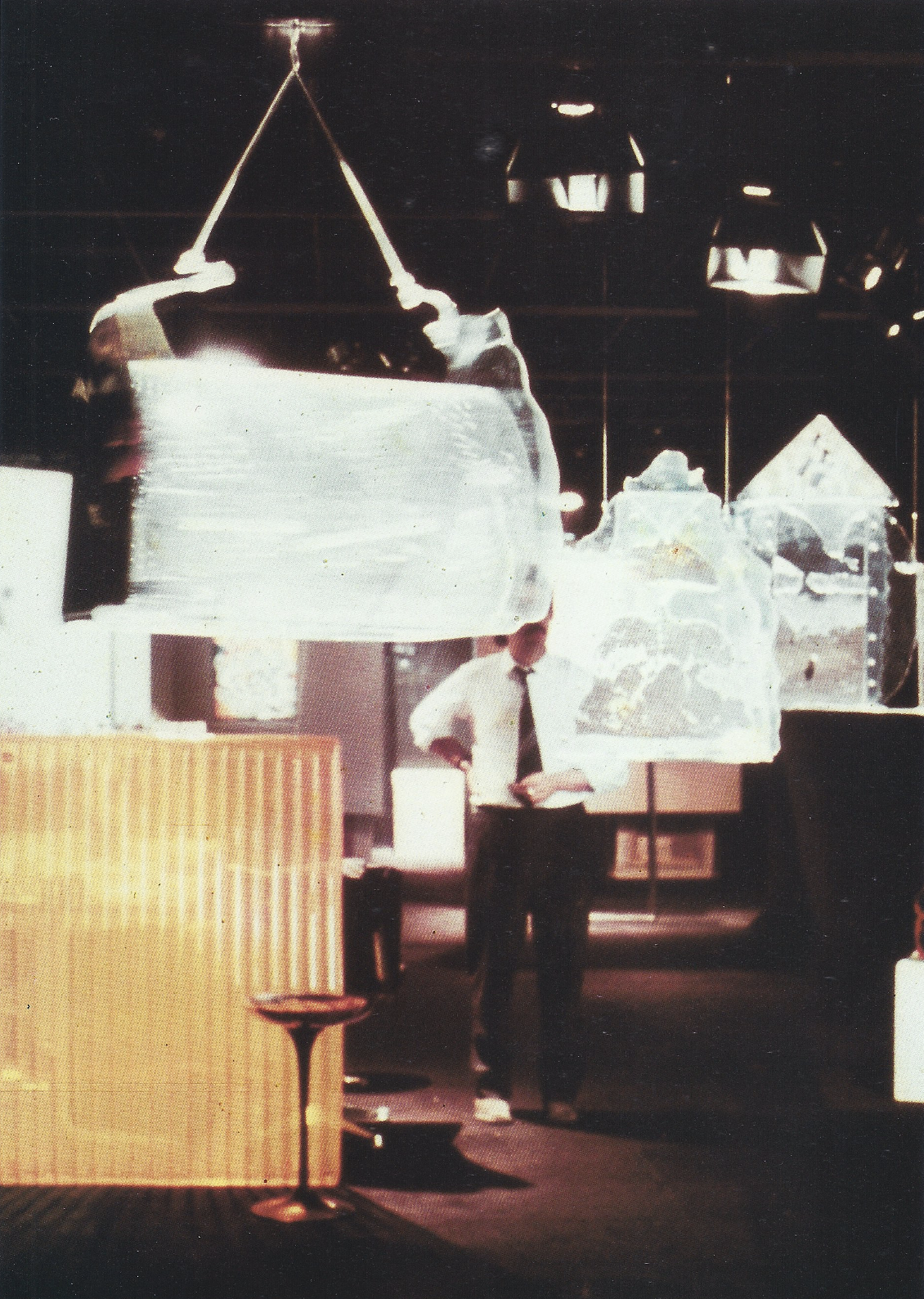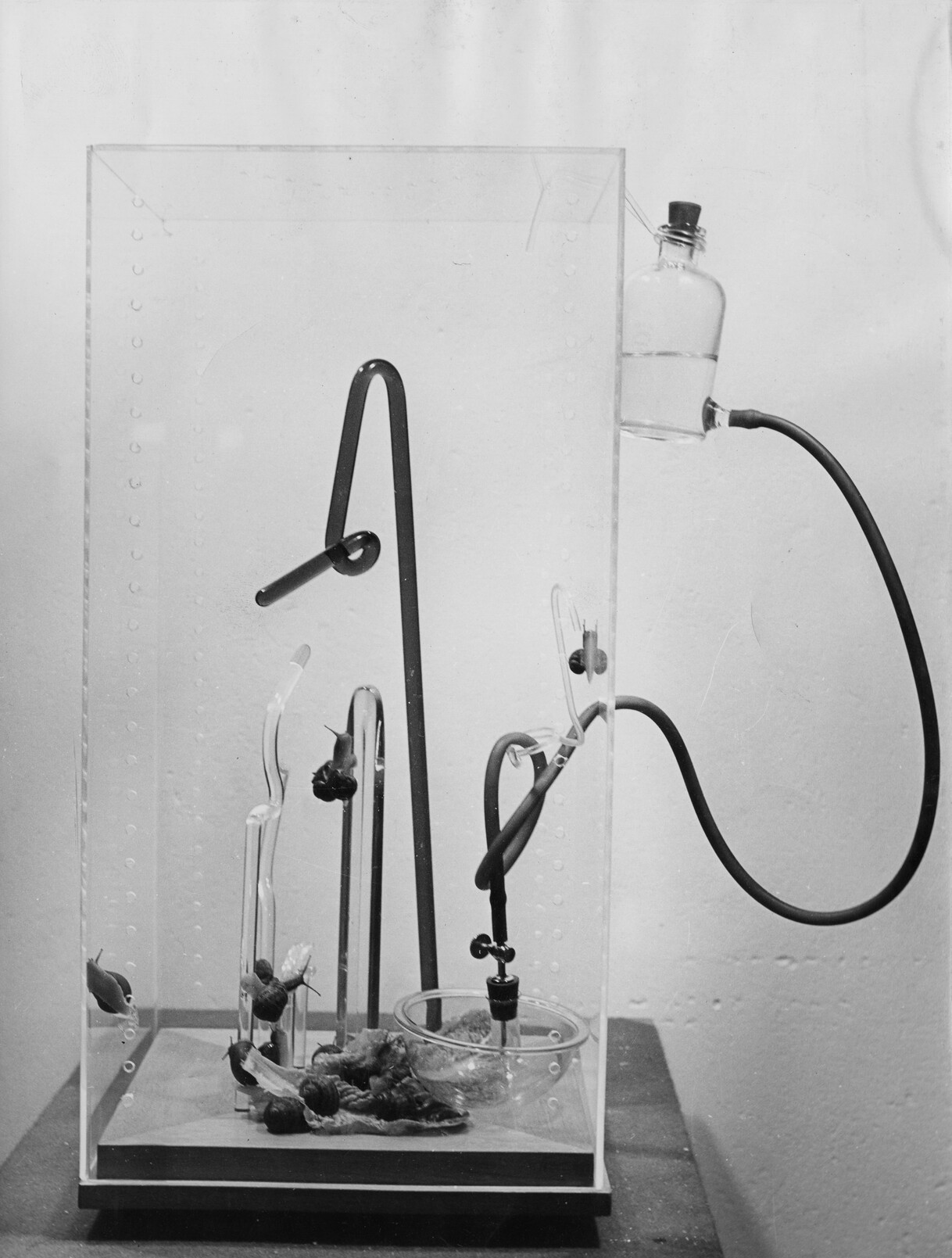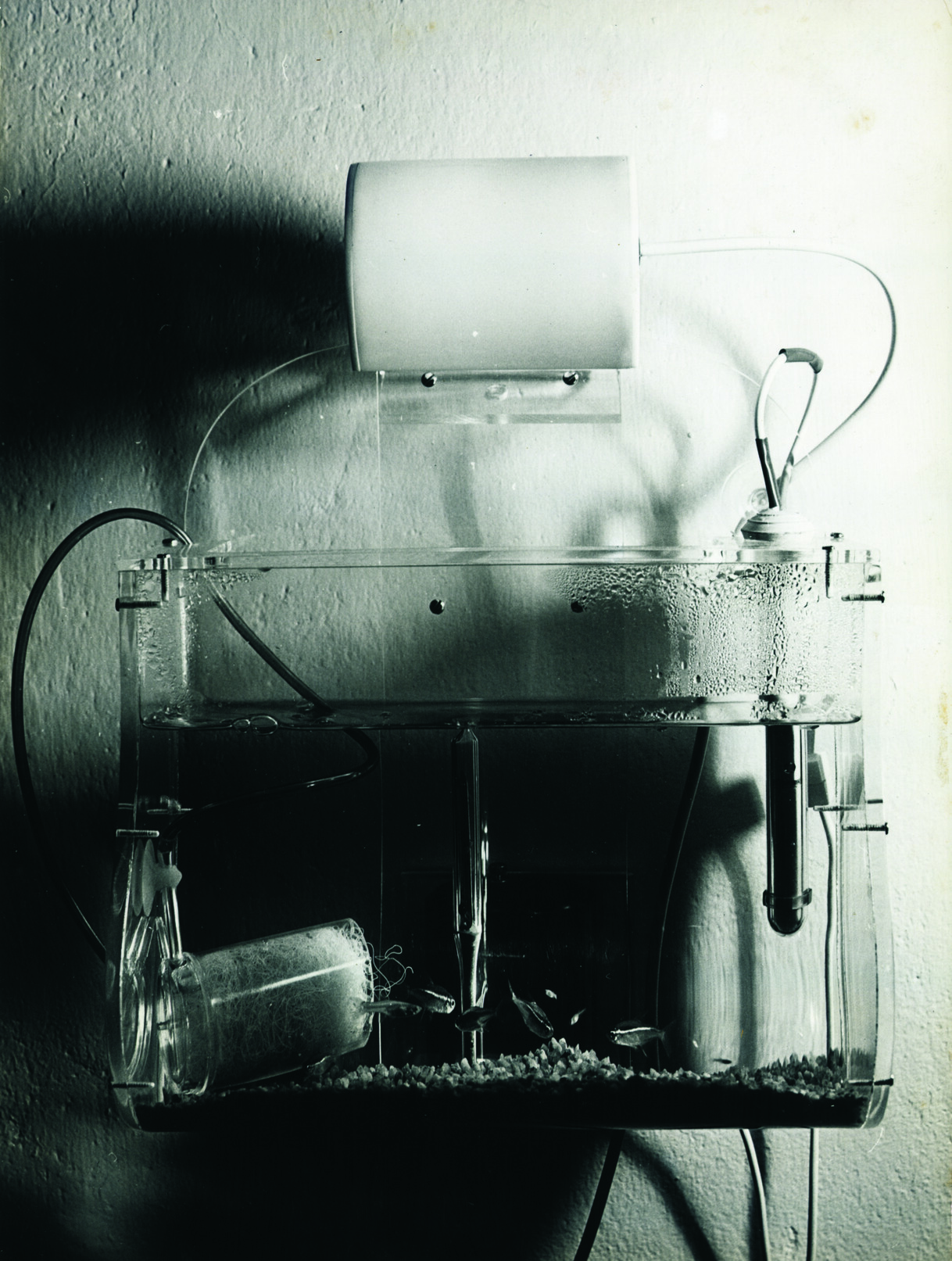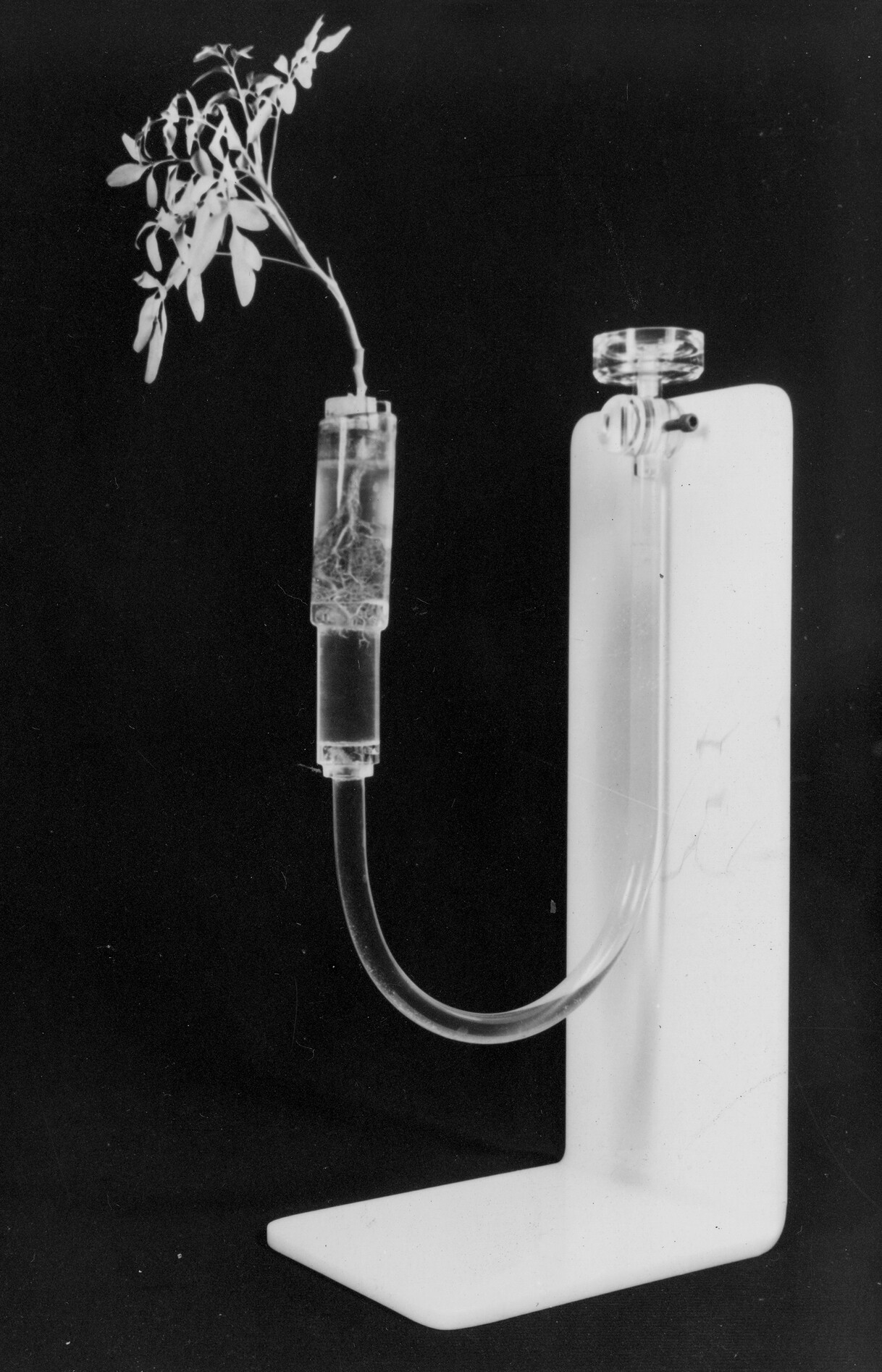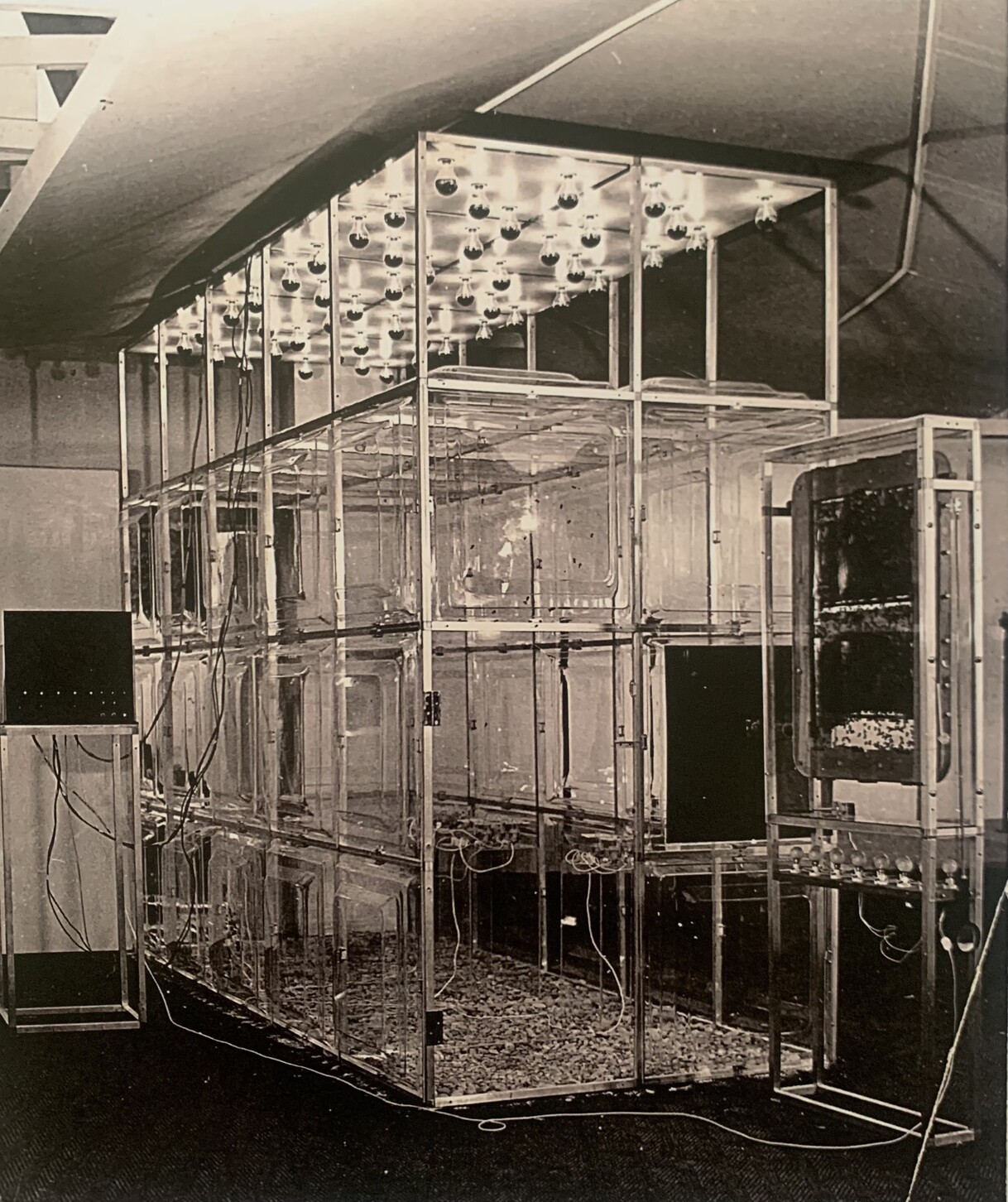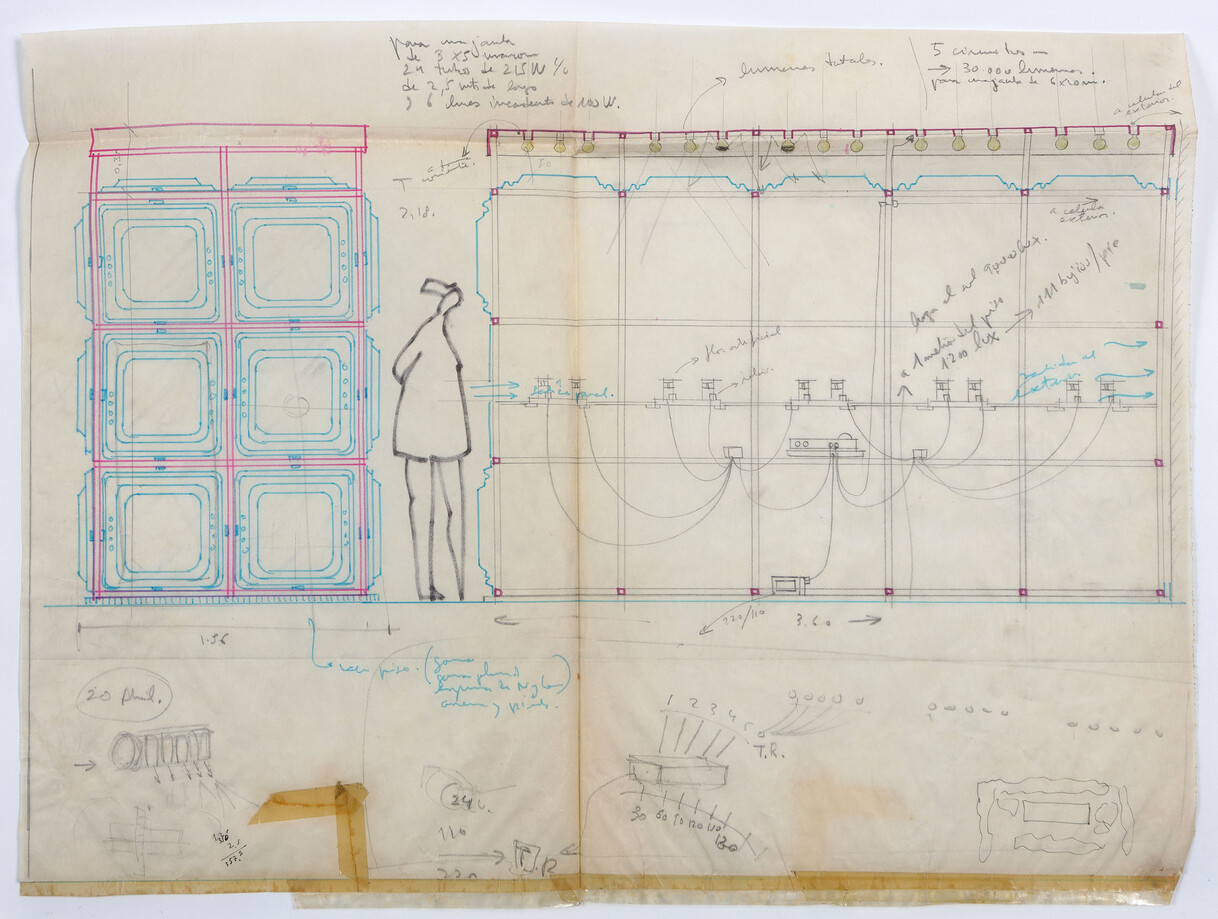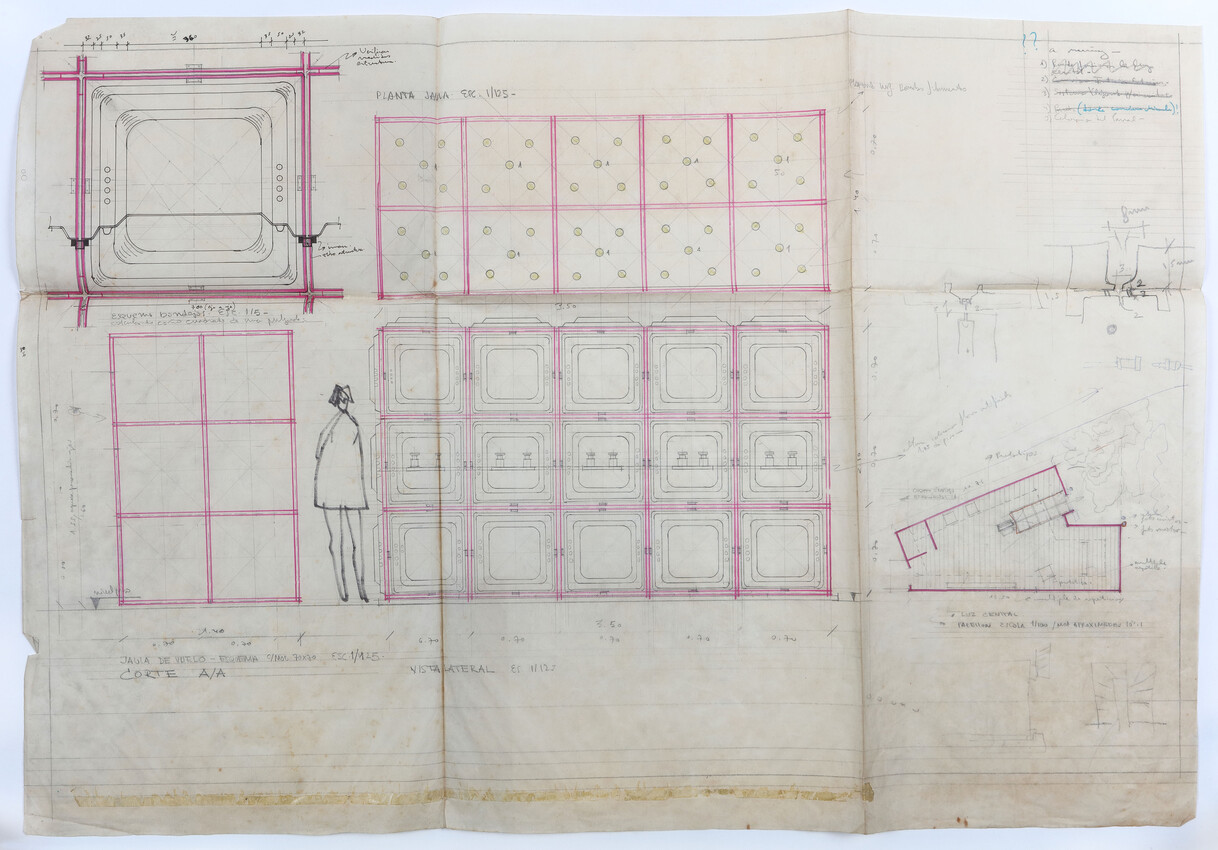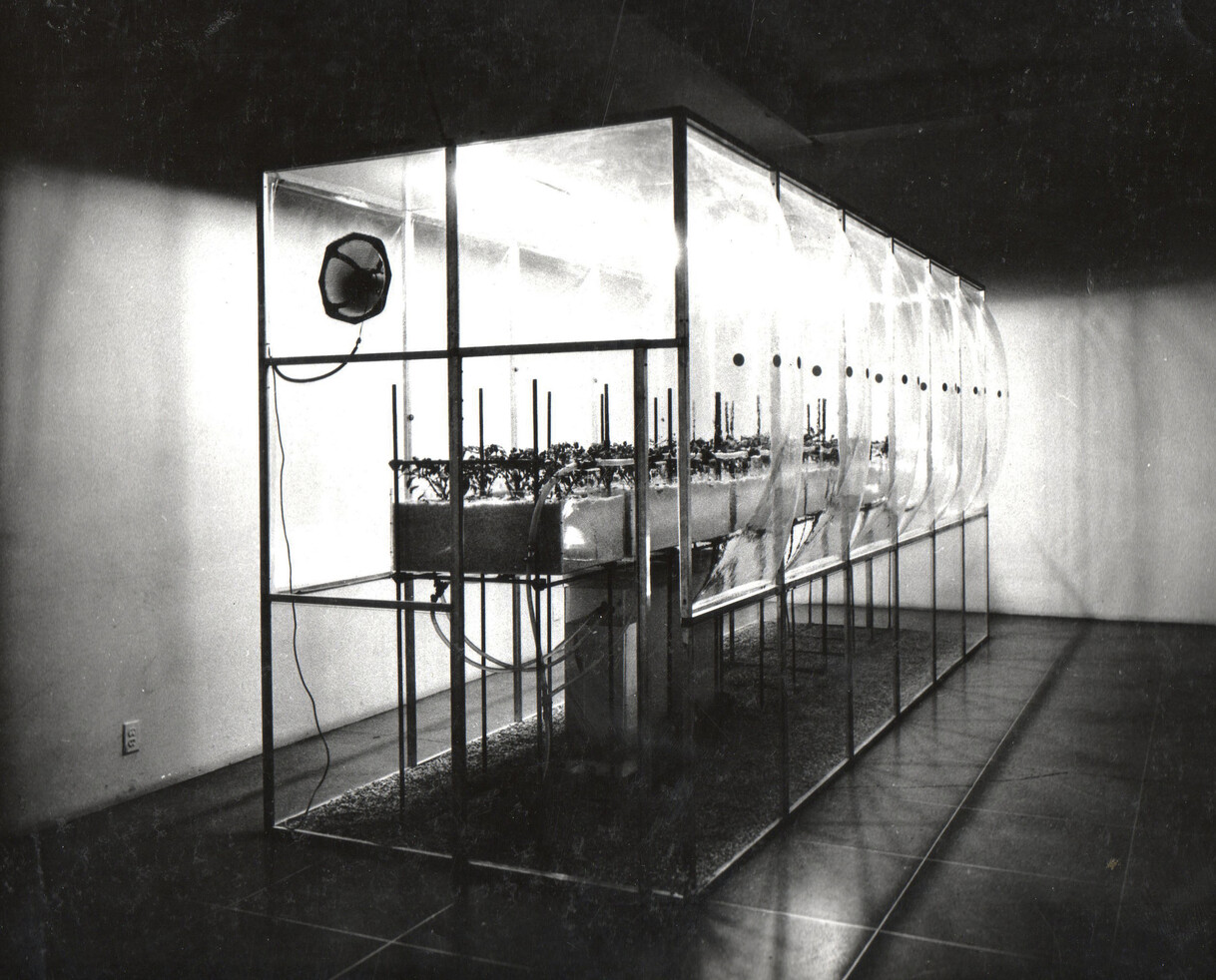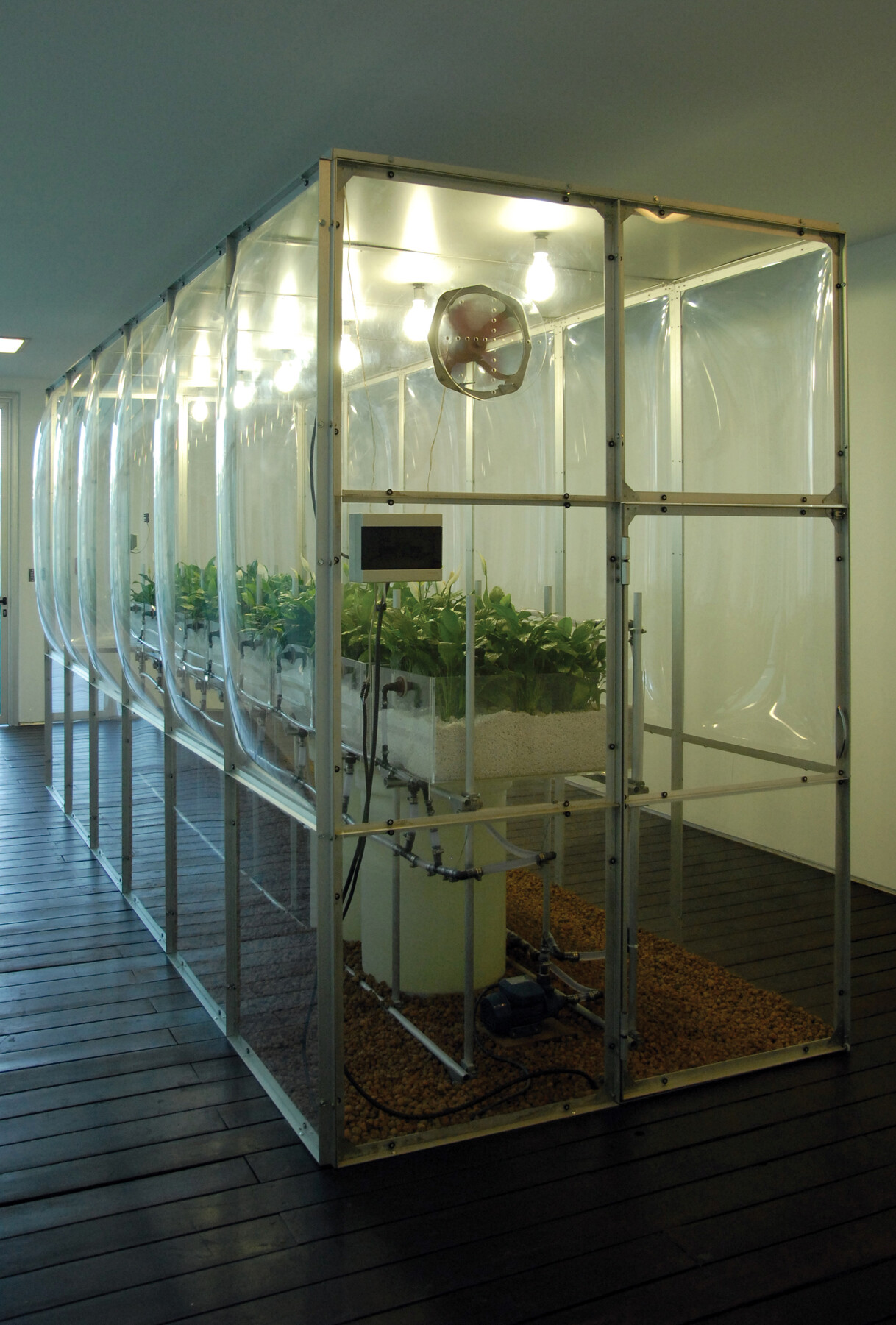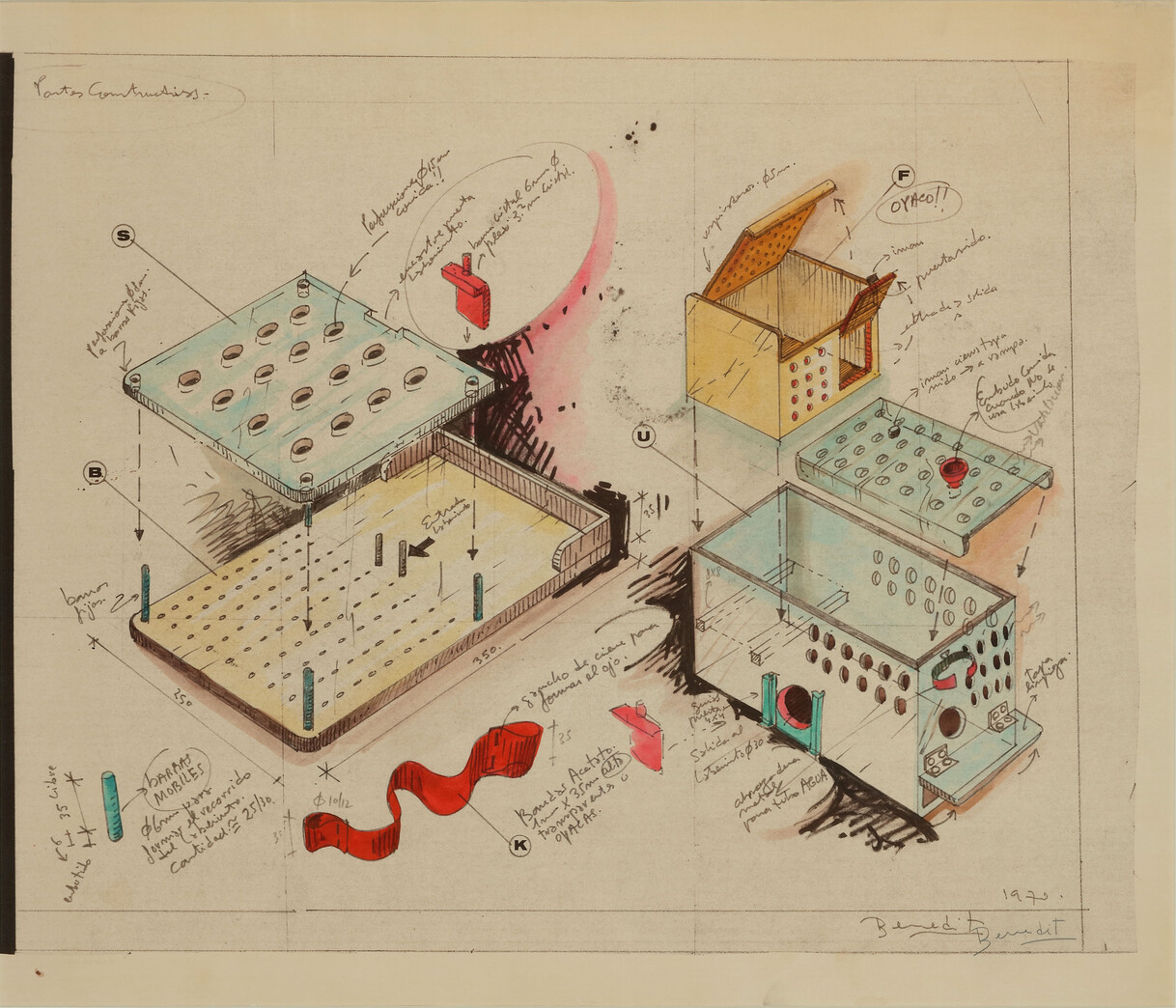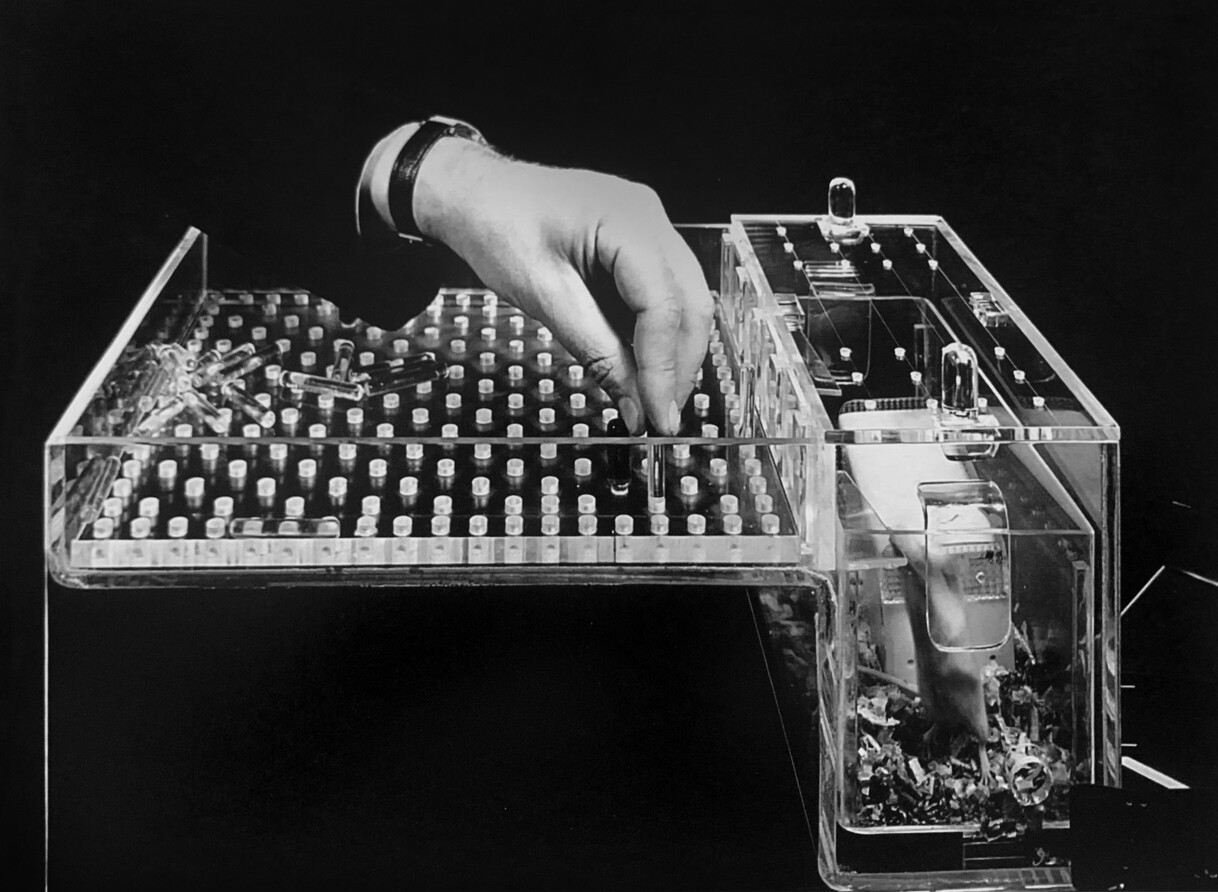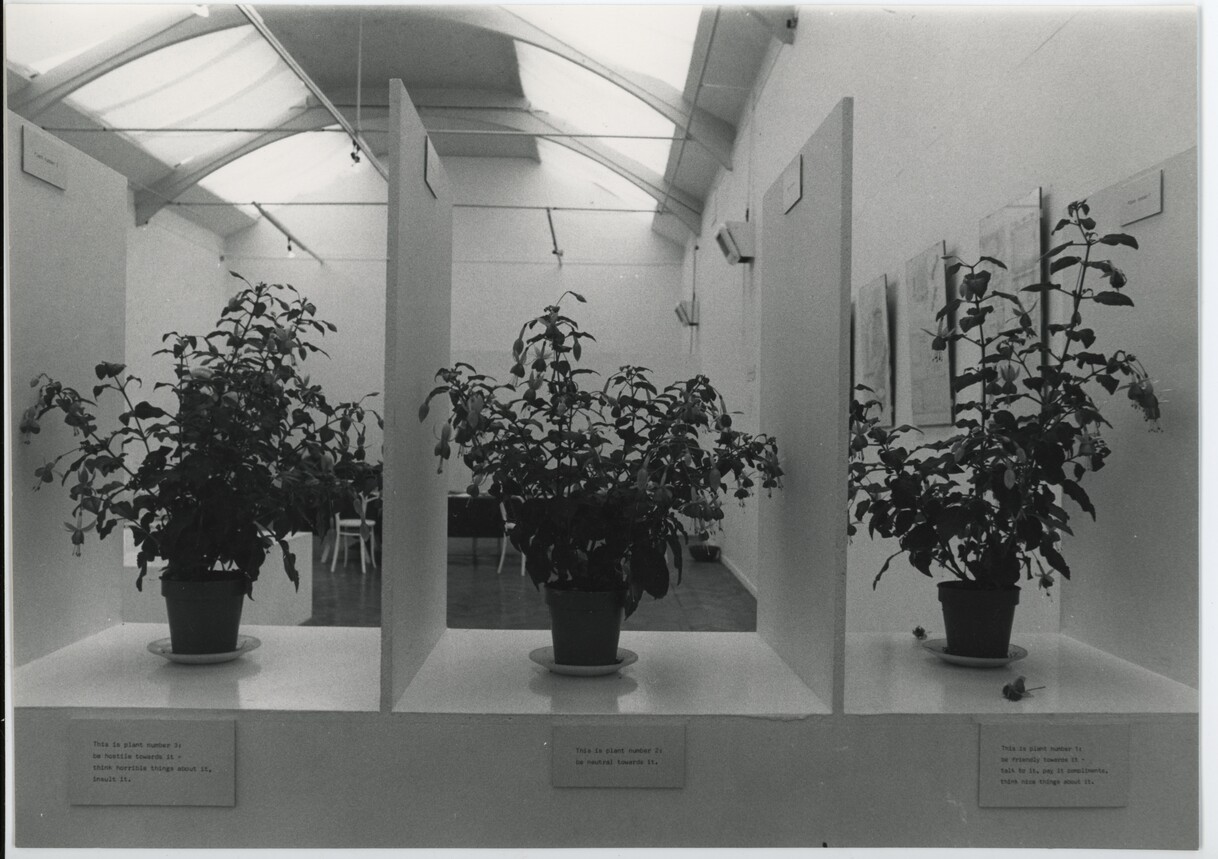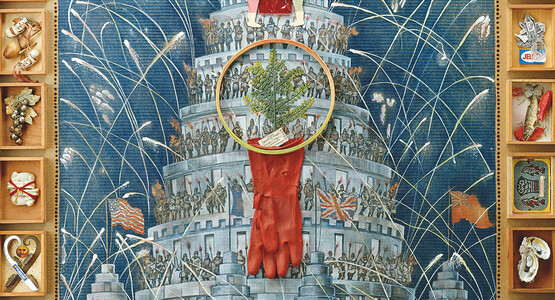Life inside a system: eco-critical stances in the art of Luis Fernando Benedit, 1968–72
by Vanessa Badagliacca • November 2021
Between 1968 and 1972 the Argentinian artist Luis Fernando Benedit (1937–2011) realised a series of works that years later the art critic Jorge Glusberg would define as ‘biological physical-chemical experiences’.1 In these works Benedit included plants, animals and even humans, presenting them as living inhabitants of his constructed environments. The installations were not created by the artist merely as empirical experiments in order to observe the behaviour of his ‘participants’. They were also devised to operate a sort of ‘antropofuguismo’ – a term that was coined by the writer Julio Cortázar over two decades later.2 This roughly translates as ‘anthropoescapism’, a perspective that, in opposition to anthropocentrism, displaces the centrality of humans in favour of non-human beings.
Benedit’s artistic research into the biological world can be broadly categorised into two groups: hydroponic environments and labyrinths. This article will analyse these elements of Benedit’s œuvre in the context of Argentine avant-garde culture in the 1960s. It will focus in particular on the artist’s Biotrón (Biotron; 1971) and Fitotrón (Phytotron; 1972), which he conceived with a team of scientists, and his Labyrinths series. In these works, in the absence of a human narrator, Benedit’s protagonists – insects, plants and animals – themselves become narrators, ‘escaping’ anthropocentrism and denying linear interpretation.3
Cybernetics, materiality and nature
In 1963 Benedit graduated from the University of Buenos Aires in architecture, a discipline that he practised professionally alongside painting. He first approached painting through informal experimentation, using layers of paint and industrial varnishes. During this early period Benedit’s research focused on exterior spaces, natural habitats and their transformation, which developed his interest in biology and botany.4 In 1967 he was awarded a research fellowship in landscape architecture at the Faculty of Architecture, Rome. He staged an exhibition at the city’s Casa Argentina that incorporated a container of live fish alongside acrylic and painted silhouettes of animals.5 While in Europe he was exposed to the work of Jannis Kounellis (1936–2017). His work at that time was also likely informed by the ‘Vivo-Dito’ (‘Living-Finger Art’) creations of Alberto Greco (1931–65). Greco began his series of live works in Paris in 1962 with Treinta ratones de la Nueva Generacíon (Thirty mice of the New Generation), which comprised a large glass tank of thirty white mice.6 Benedit’s first animal habitat work included water, objects and fish. Titled Tuttovetro y los pescados (All glass and fish), it was presented in the exhibition Materiales, Nuevas Tecnicas, Nueva Expresiones (Materials, New Techniques, New Expressions) at the Museo Nacional de Bellas Artes, Buenos Aires, in 1968. In the same year, Benedit staged a solo exhibition at Galería Rubbers, Buenos Aires, titled Microzoo FIG. 1. Here, the artist exhibited an installation that included anthills, lizards, fish, turtles, plants at different stages of germination and live bees.7
The presence of living beings in Benedit’s installations occurred during a widespread proclivity for ‘dematerialisation’ in art practices. In 1967 the theorist and critic Oscar Masotta (1930–1979) delivered a lecture titled ‘Después del Pop: nosotros desmaterializamos’ (‘After Pop: we dematerialise’) at the Instituto Torcuato Di Tella, Buenos Aires. As the title reflects, Masotta noted a turn away from Pop art towards a ‘dematerialisation’. The term derives from the Russian Constructivist El Lissitzky (1890–1941), who wrote about a diminishing of materials, such as paper and letters, as a result of the rise of new communication technologies in the early twentieth century.8 Although, as Elize Mazadiego notes, this lecture has come to define the artistic experiments in Argentina known as ‘arte de los medios de comunicación de masas’ (‘mass media art’), it is also key for thinking about the progression of ‘dematerialisation’ as a concept in the 1960s.9 Lippard visited Argentina a year after Masotta’s lecture, in 1968, which some scholars have argued greatly influenced Lucy R. Lippard’s notion of dematerialisation – a ‘de-emphasis on material aspects’ in art practices.10
In a manner that directly interpreted and expanded not only the dematerialisation of art but also the ‘multiple possibilities of formalisation’,11 Benedit created Microzoo to highlight the contradictions between nature and culture. A review published in Revista Primera Plana on 3rd December 1968 described the exhibition as ‘the result of the happy marriage between art and biology’.12 Moreover, writing a decade later, Glusberg termed the work of Benedit – along with that of Víctor Grippo (1936–2002) and Gregorio Dujovny (1925–90) – as ‘scientific imaginary’, that is, work that was capable of overcoming the Manichean opposition between art and science, which was prevalent in cultural discourse at the time.13 In the 1930s William Frederick Gericke (1882–1970) developed the process of hydroponics – the cultivation and growth of terrestrial plants in the absence of soil, replaced by mineral nutrient solutions dissolved in water. Benedit researched these experiments, incorporating their principles in a number of his works, such as Germinaciones (Germinations) (1968), Habitat para caracoles (Habitat for snails) FIG. 2, Pecera para peces tropicales (Fish tank for tropical fish) FIG. 3, Gota de agua (Water droplet) FIG. 4 and Evaporador de Sachs (Sachs evaporator) FIG. 5. Despite bringing scientific research into the realm of contemporary art, Benedit did not consider his work to be experimental, believing that his actions were ‘embedded in the art field, seeped by aesthetics and [could] be judged without any ideology’. He stated that ‘any unprepared spectator [could] see it with strictly plastic parameters’. However, he continued, ‘This does not mean that my results are not ideologically charged’.14
Such works can be framed within the increasing influence of cybernetics on contemporary art across Europe and the Americas towards the end of the 1960s. The term ‘cybernetics’ was first employed by Norbert Wiener in his influential book Cybernetics: Or Control and Communication in Animal and Machine (1948). The text addresses the science of machines and how information is translated into control and regulation within a given system, whether it be mechanical, biological, cognitive or social. The popularity of this phenomenon is evidenced by the contemporaneous staging of several exhibitions, including Cybernetic Serendipity, curated by Jasia Reichardt at the Institute of Contemporary Arts, London (ICA), in 1968, and others held in New York, Toronto and Buenos Aires between 1968 and 1971, respectively.15
In 1969 Glusberg founded the Grupo de Arte y Cibernética Buenos Aires with the aim of promoting cybernetics in the city. Benedit was also a founding member, along with the artists Osvaldo Romberg (1938–2019), Antonio Berni (1905–81), Miguel Ángel Vidal (1928–2009) and Eduardo Mac Entyre (1929–2014). Their first group exhibition, Arte y Cybernetica, was staged at the Centro de Estudios de Artes y Comunicación, which had been founded by Glusberg a year earlier. Writing in the exhibition catalogue, Glusberg offered an overview of ‘art of our days’, setting out the parallels between artistic discourse and cybernetics, concluding that artists were more interested in process than a finished work. As such, they embraced ‘a net of uncertainties, ambiguities, a field where nothing is established. The artist of this time is more interested in behaviour than in the essence of things; this tendency can be clearly identified with cybernetic vision’.16 Glusberg also highlighted the position of the artist, no longer isolated in an ‘ivory tower’, but instead working with technologists to pursue and develop research. He details a ‘new art’ a ‘living art’ made by practitioners who use ‘ideas, synthetic shapes or mathematical equations instead of paintings; lights and motors, and information instead of brushes’.17
Living systems
In 1971 Benedit was selected by a committee, composed of the art critics Jorge López Anaya, Fermín Fèvre and Carlos Claiman, to present his work at the Argentinian pavilion for the 35th Venice Biennale, titled Art and Science. The result was Biotrón FIG. 6, a collaborative work with the scientist Antonio Battro (b.1936), who worked in artificial intelligence at the Consejo Nacional de Investigaciones Científicas y Técnicas (CONICET); the ethologist Josué Núñez (b.1924); and Glusberg, who offered technical and financial support in order to take to the installation to Venice.18
Biotrón was a transparent acrylic and aluminium structure measuring five metres long, two metres wide and three metres high FIG. 7. It held twenty-five artificial flowers, which played host to four thousand living bees, sustained by fifty 100-watt lamps. One end of the structure was open, exposed to the natural elements of the Giardini, and at the other end Benedit placed a transparent beehive, allowing visitors to see the activity of the bees. At the direction of a computer, the artificial flowers exuded drops of sugar at regular intervals. This experiment effectively gave the bees a choice between artificial flowers and the outside gardens with real flowers; the bees preferred the former.19 The work was considered legitimate scientific research to such an extent that it was subsequently used in an experiment at the National University of Buenos Aires.20 Today, the physical work no longer exists, it is known only from photographs and drawings FIG. 8. This device of life, as the title reminds us, urges us to not look at nature and culture as distinct, but instead as ‘naturecultures’ – so tightly interwoven that they cannot be separated.21
In 1972 Benedit became the first Argentinian artist to present a dedicated solo show at the Museum of Modern Art, New York (MoMA). MoMA’s interest in Benedit’s practice may have been connected to a previous exploration in this field of enquiry: the exhibition The Machine as Seen at the End of the Mechanical Age, which the museum hosted in 1968.22 It featured two hundred works of art, among them Tom Shannon’s Squat (1966), an interactive sculpture in which visitors could touch a living plant to activate a robotic arm. A few decades later the Brazilian artist Eduardo Kac defined Shannon’s installation as ‘the first interactive artwork that is an organic and inorganic hybrid, raising the question of cybernetic entities so relevant to current debates’.23
For his exhibition at MoMA, Benedit presented two man-made environments for living organisms: a hydroponic environment entitled Fitotrón FIG. 9 and Laberinto para ratones blancos II (Labyrinth for white mice II). Fitotrón consists of a climatic chamber in aluminium and acrylic, measuring five metres in length and containing hydroponically cultivated plants sustained by artificial lamps. It is currently part of the permanent collection at the Museo de Arte Latinoamericano de Buenos Aires (MALBA) and is exhibited in temporary exhibitions displaying the collection FIG. 10. This suggests that Fitotrón today exists solely as a record of its original conception, rather than as a ‘living’ work that interacts with the contemporary and local context in which is located.
Prior to Benedit’s creation for MoMA, the term ‘phytotron’ already existed; it was the unofficial name given to the Earhart Plant Research Laboratory at the California Institute of Technology in 1949 by the plant physiologists James Bonner and Fritz Went. It derives from the Greek ‘phyton’, meaning plant, and ‘tron’, which has come to mean device.24 In comparison to open-air fields or greenhouses where a climate could be maintained for the benefit of a whole range of plant species, a phytotron is designed to stay in a closed, artificial space, encompassing an entire building of rooms in which climatic conditions are replicated. In other words, a phytotron is a computer-controlled greenhouse.25
The phytotron incorporates the total control of light intensity, temperature, humidity, levels of water and nutrients. At the time, it was praised as a ‘multi-science’, as it operated on collaboration between botanists, physiologists, biologists and physicists. Its main purpose was to reproduce in the biological sciences the epistemological basis and certainty of physical sciences; or as David P.D. Munns noted, ‘that was the dream at least’.26 However, in fact, as soon as phytotrons were built in different countries, universal knowledge could not effectively be applied to the study of local botanical specificities. Moreover ‘the breakdown of organisms into precise and reproducible parts (the model of the physical sciences) did not map completely onto the biological sciences’.27 In the framework of the history of science, Munns argues that phytotrons represent ‘not only a key shift in the epistemology of biology but also an underexplored case of science’s relationship to the nation-state’.28 Framing this discovery in its historical context, phytotrons reflected the modernist optimism in so-called ‘big science’, a result of the exchange between science, technology and government after 1945 and during the Cold War.29 The phytotron became ‘a model production system’ and simulated not one place but many. Like a nation, the phytotron both delineated a distinct national maturity and evoked a sense of belonging in the international community, recalling ‘the goal of reductionist science’. However, by the end of the 1960s it became evident that a crisis was taking place in the realm of science. There was an increasing hostility towards the discipline by younger generations, which perhaps originated from its ‘mis-use and abuse’, as a phenomenon that was ‘part of a larger crisis in society’.30 Scientists held divergent views on the very nature of scientific knowledge, which ranged from an establishment use–abuse model to a radical critique shaped by ideology on the other.31
Separated from its function, Benedit’s Fitotrón is an interesting case study in terms of the science embedded within it FIG. 11 as well as its relationship to dynamics of identity and ‘otherness’ between hegemonic countries and colonised countries. It is significant that Fitotrón was conceived for an exhibition in the United States, where this botanical device was first invented and produced, and had gained international reach by the time it was shown. It alludes to the responsibility of large organisations – or monocultures32 – for the loss of local plants and biodiversity as a result of the monopoly of seeds by such American multinationals as the agrochemical and agricultural biotechnology corporation Monsanto. In the late 1970s the Argentinian art critic Carlos Espartaco praised Benedit for his ‘ethno-botanic approach’, describing Fitotrón as ‘a scientific contribution that can lend fruitful collaborations, associating in the most efficient way natural and human sciences and art’.33 He also highlighted the potential of hydroponic cultivation for mass consumption as an ally against ‘the exhaustion now being suffered by natural cultivation territories’.34 This optimistic approach regarding the use of this device clearly disregarded the potential history of plants as a history of domination, violence and colonisation.35 In this regard, Munns recognised a straightforward ‘postcolonial lesson’ in the application of the principles of physics made by botany. The phytotron served ‘to emulate, to reproduce, what [was] regarded as a superior epistemology to gain knowledge about the natural world’ and in this way the science of biology was ‘firmly colonised’:
When one succeeds in building a scientific facility that universally controls whole climates and can exactly reproduce environmental variables, he does not merely replicate imperial triumph but makes the colonizers’ entire worldview into a joke, because it is not that plants can be like physics but that physics can be plants.36
Such is the paradox of Benedit’s Fitotrón: it is not that plants can be like physics, but that physics can be plants. Furthermore, physics can be transferred to an artistic context when its purpose is no longer to display alternatives for nourishing the exponential growth of a population, but instead to inform communities that they themselves are part of a computer-controlled greenhouse, which affects their body, thought processes, beliefs and decision-making within a social system. Here an ‘anthropoescapist’ perspective is activated to make one think not only about environmental breakdown but also about issues of social justice and the connections between capitalism and inequality.
In Benedit’s works from this period, he brings together the disciplines of art and science, demonstrating both the potential and pitfalls of such a collaboration. His live plant installations might be envisioned as a reflection on the power dynamics between colonising and colonised nations that governed scientific development at the time. Although the artist did not explicitly declare any statement of this kind, as an extension of the subjects and methods he chose, his practice is necessarily integrated in hegemonic Western artistic, scientific and pedagogic contexts.37 In addition, as a white Argentinian man he problematises the dichotomic borders between centre and periphery within his own country, the identity of which must try to accommodate its European cultural influences alongside the racism, indigenous population loss and erasing of Black-Argentine narratives that colonialism brought about.
The ‘Labyrinths’
The second work Benedit presented at MoMA was Laberinto para ratones blancos II FIG. 12. Although the mice were provided with water, in order to receive food they were required to solve the labyrinth’s path which lengthened and became more complicated every forty-eight hours.38 The work presented an analogy between the behaviour of the mice, determined by a series of obstacles to achieve sustenance, and human behaviour, regulated by the social systems of competition and objectives FIG. 13.
In 1972 Benedit created three more labyrinths for a solo exhibition at Galerie Buchholz, Munich: Laberinto para cucarachas (Labyrinth for cockroaches) FIG. 14; Laberinto para hormigas (Labyrinth for ants), which explored the cooperation of ants to secure food compensation FIG. 15; and Laberinto vegetal (Vegetal labyrinth), which challenged the integral mobility of a labyrinth. The last work comprised a box in which seeds were planted to grow in the direction of a 40-watt lamp. Once the plant began growing it was forced to choose between a series of right or left paths in order to follow the light.
Together with twelve other Argentinian conceptual artists, including Grippo and Carlos Ginzburg (b.1946), Benedit was a member of Grupo de los Trece (Group of the Thirteen), which was founded in 1971 by Glusberg. That year Glusberg also curated the exhibition Arte de Sistemas I at the Museo De Arte Moderno, Buenos Aires, which later travelled to Camden Arts Centre, London. Both iterations featured Benedit’s Laberinto invisible (Invisible labyrinth; 1971). As declared in the exhibition catalogue, ‘arte de sistemas’ (‘systems art’) was used by Glusberg to collate the latest tendencies in art of the second half of the twentieth century, referring to ‘art as idea, ecologic art, arte povera, cybernetic art, art of proposals, political art’.39 Moreover, referring to Latin American artists, Glusberg classifies systems art as ‘an attempt to establish the necessary intersection existing between a group of discourses previously selected, and the concretion of an apt model, able to make viable a reading of the formation process of the same’.40
Laberinto invisible is the sole work that Benedit conceived of to be performed by a human FIG. 16. In a six-metre-long space, fit with mirrors that reflect beams emitted by a lamp, the visitor was invited to traverse an invisible maze for rats expanded to human scale. The visitor could only find the correct path through a process of trial and error, with an alarm sounding when a light beam was interrupted. At the end, the visitor’s reward was to observe the behaviour of a Mexican axolotl, an amphibious animal said to be related to the origins of human species.41 A possible inspiration for the labyrinth was the short story Final del juego (End of the game) by Cortázar (1956). In one passage of this first-person narration, he describes an axolotl:
The eyes of the axolotl spoke to me of the presence of a different life, of another way of seeing […] I began to see in axolotls a metamorphosis which could not erase a mysterious humanity. I imagined them consciously, slaves of their bodies, infinitely condemned to an abyssal silence, to a hopeless reflection. Their blind gaze, those minute inexpressive golden discs, but terribly lucid, seeped through me like a message: ‘Save us, save us’. […] They were not humans, but in no animal had I ever found such a deep relationship with me. The axolotls were like witnesses of something, and sometimes like horrible judges.42
In Laberinto invisible, Benedit emphasised binary oppositions: mirrors and light; sound and silence; punishment and reward FIG. 17. The piece revolves around two equivalents: the permanence of the initial conditions (positive route) and the temporary sound of the alarm (negative route). Continuity is guaranteed by the successful completion of the labyrinth, while discontinuity is provoked by continual error until the final objective: the moment when the participant has interiorised the correct route of the labyrinth.43 As Glusberg noted:
The process of behaviour adaptation as related to error (learning curve) constitutes an obvious feed-back mechanism which allows the participant to adapt to the mechanics of the system until he becomes part of it. ‘Trial and error’ obliges one to memorise and register the alternatives of the positive path.44
This interpretation, however, remains anchored to the ‘logocentric world’, a term coined by the philosopher Maurizio Lazzarato (b.1955), who asserts that with capitalism we entered a ‘machine-centric’ world that affects ‘the functions of language in a different way’.45 If following this ideology, one might note that Glusberg’s interpretation is focused on the individual, whereas in the ‘machine-centric’ world there is a shift from subject to subjectivity such that enunciation does not primarily refer to speakers and listeners but to ‘complex assemblages of individuals, bodies, material and social machines, semiotic, mathematical and scientific machines, etc., which are the true sources of enunciation’.46 Bypassing language and representation, the vibrant agency of materiality present in Benedit’s works is a more-than-human force that inflects entire ecosystems and their functioning.
In his analysis of Laberinto invisible, Daniel R. Quiles proposed an analogy between the two types of labyrinths, visible and invisible, described in Jorge Luis Borges’s short story Los dos Reyes y los dos Laberintos (The Two Kings and the Two Labyrinths). Quiles emphasises the metaphorical meaning inherent in Borges’s text, reflecting on the political situation in Argentina at that time – it was ruled by a dictatorship between 1966 and 1973 and an even more violent and repressive one between 1976 and 1983 – while also placing it in an international context. One may add that the invisibility in Benedit’s labyrinth can be interpreted as a metaphor of ‘the system’ – controlling and customising our behaviours in relation to compensation or consumption, and to being accepted by its rules.
Conclusion
After creating numerous works of art with botanical and zoological habitats, labyrinths and artificial cultivations between the late 1960s and the early 1970s, Benedit sensed that he was ‘a suspicious being to artists and much more suspicious to scientists’, and as such felt that he had no more to offer to the field.47 Nevertheless, on two future occasions, he exhibited works with zoological and botanical elements. One such occasion was his exhibition at the Whitechapel Gallery, London, from 29th May to 6th July 1975. The exhibition comprised fifteen art-science objects and seventeen accompanying watercolour drawings. One of the objects, Plant experiment (1973), comprised three plants, each accompanied by a set of instructions from Benedit. The public were invited to ‘be friendly’ to the first plant, to ‘pay it compliments, think nice things about it’; they were supposed ‘be neutral’ to the second; and ‘be hostile’ to the third, to ‘think horrible things about it, insult it’. Reflecting the exhibition Benedit commented on how – contrarily to what one might expect – it was the plant treated with words of love dried out first after a few days FIG. 18.48
Benedit utilised the agency of matter as an active principle to create living narratives, which interrogate ecosystems and human participation within them.49 Through this lens, those considered simply as ‘biological physical-chemical experiences’ will appear as part of the merger of art and politics in the context of Latin American conceptualism of the time, which ‘not only gave identity and purpose to the role of art in society but also served as a strategy to effect change’.50 One possible reason for his resignation from this form of artistic research could be a loss of faith in science and the entanglements between systems art and cybernetics. What is remarkable in Benedit’s works with plants and animals is his contribution to broadening ideas of conceptual art at the time. He ‘dematerialised’ – following Masotta’s concept – in order to materialise anthropoescapist scenarios that enact eco-critical encounters between art, science and politics.
Acknowledgments
This article forms part of the present author’s PhD thesis and combines and develops two papers: ‘Materialising fairy tales: the animals inhabiting the art of Luis Benedit’, given at the seminar ‘On the Lives and Sounds of Animals’ at the ACLA (American Comparative Literature Association) Annual Meeting, Harvard University, Cambridge MA, 17th–20th March 2016; and ‘Hydroponic environments in the artistic context: the case of Luis Benedit’s “Fitotrón”’, given at a workshop entitled ‘The exploration of scientific ideas in Latin American art and literature’ at the symposium Science and Culture in Theory and History: Latin America, France, and the Anglophone World, held at the University of Cambridge, 2nd–3rd July 2016. The author would like to thank the anonymous peer reviewers for their generous and constructive feedback.





